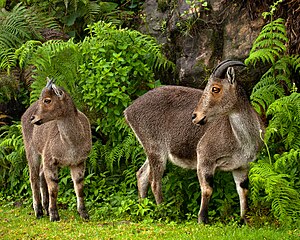Nilgiri-Tahr
| Nilgiri-Tahr | ||||||||||||
|---|---|---|---|---|---|---|---|---|---|---|---|---|

Nilgiri-Tahr ( Nilgiritragus hylocrius ) |
||||||||||||
| Systematics | ||||||||||||
|
||||||||||||
| Scientific name of the genus | ||||||||||||
| Nile Giritragus | ||||||||||||
| Ropiquet & Hassanin , 2005 | ||||||||||||
| Scientific name of the species | ||||||||||||
| Nilgiritragus hylocrius | ||||||||||||
| ( Ogilby , 1838) |
The Nilgiri-Tahr ( Nilgiritragus hylocrius , until 2005 Hemitragus hylocrius ) is a goat-like cloven - hoofed species living in southern India .
features
Nilgiri tahrans have a goat-like shape. They reach a head body length of 110 to 150 centimeters, to which a 10 to 15 centimeter long tail comes, and a shoulder height of 80 to 110 centimeters. They are thus the greatest representatives of the Tahre . At 80 to 100 kilograms, males are significantly heavier than females, who only weigh around 50 kilograms.
In contrast to the Himalayan tahr , their fur is short. In females and young males it is yellowish-gray in color and has a dark stripe on the back; in males, the fur changes color to chocolate or black-brown with increasing age and a silver-colored, saddle-like mark on the back becomes visible. Older males' faces also have two silver-colored stripes.
Both sexes have relatively small, curved horns. Those of the males are up to 45 centimeters long, those of the females are significantly slimmer and reach a maximum of 30 centimeters.
distribution and habitat
Nilgiri-Tahre occur exclusively in the Nilgiris on the border of the southern Indian states of Kerala and Tamil Nadu . Their habitat is grass-covered mountainous areas at 1200 to 2600 meters above sea level.
Way of life
Nilgiri-Tahre are predominantly crepuscular. In the early morning and in the late afternoon and evening they go in search of food, in the midday heat they rest in the shade of rocks. They are skilled climbers who move safely in their rugged habitat. These animals are herbivores that feed primarily on grasses and herbs.
The group behavior of the Nilgiri Tahre is flexible. Herds consist of 20 to 70 animals, in individual cases more than 100 animals are grouped together. Females live with their young in their own herds, the males also form bachelor groups or live solitary. During the rutting season, males join groups of females, but there have also been reports that males and females live in mixed-sex groups throughout the year. During the mating season, the males sometimes have bitter battles for the mating privilege, which can also end with the death of a competitor.
The mating season is from June to August, and most births occur after a gestation period of around 180 to 190 days in January and February. Usually a single young is born, twins are rare. The young are weaned after four to six months and are sexually mature at two to three years of age.
Danger
The main dangers for the Nilgiri-Tahr are the destruction of the habitat and poaching. Due to human settlement activity, their habitat is severely fragmented and divided into many, often small populations. Although the species is protected in India, the implementation of this protection and the prevention of poaching are often inadequate. The total population is estimated at 2000 to 2500 specimens, the largest population with around 1000 animals lives in the Eravikulam National Park in Kerala.
Systematics
Originally, the Nilgiri Tahr was with the Himalayan Tahr and Arabian Tahr representing the Tahre within the genus Hemitragus out. According to molecular genetic investigations by Ropiquet and Hassanin 2005, however, the tahre are not very closely related and a common genus cannot therefore be maintained. According to these studies, the Nilgiri Tahr is more closely related to the sheep , so the authors suggested placing the species in its own genus, Nilgiritragus .
literature
- Ronald M. Nowak: Walker's Mammals of the World. Johns Hopkins University Press, 1999, ISBN 0-8018-5789-9 .
- A. Ropiquet, A. Hassanin: Molecular evidence for the polyphyly of the genus Hemitragus (Mammalia, Bovidae). In: Molecular Phylogenetics and Evolution. Volume 36, No. 1, 2005, pp. 154-168.
Web links
- Distribution map, photos and further information
- Nilgiritragus hylocrius in the endangered Red List species the IUCN 2014 Posted by: M. Alempath and C. Rice, 2008. Accessed November 21, 2014.
- The Nilgiri Tahr Foundation
